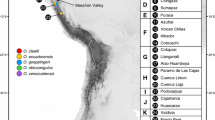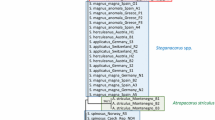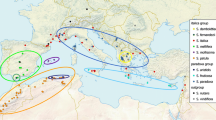Abstract
The genetic structure of 10 populations of the Merodon aureus group from the Balkan Peninsula was examined through allozyme electrophoresis and mitochondrial DNA sequencing of the cytochrome c oxidase subunit I (COI). Six diagnosable cryptic taxa were identified within the morphologically defined species M. aureus Fabricius, 1805 and M. cinereus (Fabricius, 1794), with clear separation of the populations (((M. aureus A + M. aureus B) + cinereus complex) + M. aureus C). The parsimony analysis of COI sequence data of the aureus–cinereus complex using Merodon avidus A species as an outgroup resulted in two main clades, (M. aureus A + M. aureus B) and ((M. aureus C + M. cinereus B + M. cinereus C) + M. cinereus A), which differed on average by 5.7%. The observed spatial distribution of the taxonomic diversity of the group suggested that these taxa originated from a common ancestral population in the Mediterranean. Identification of genetic uniqueness and genetic endemism emphasizes the importance of molecular markers and estimation of genetic diversity in recognition of conservation units. The primary goals of the conservation measures that we propose are the protection of phylogenetic lineages within the highly diverse M. aureus group taxa and conservation of the genetic variation through management of important areas.





Similar content being viewed by others
References
Avise JC (2000) Phylogeography: the history and formation of species. Harvard University Press, Cambridge, MA
Ayala FJ, Powell JR (1972) Allozymes as diagnostic characters of sibling species of Drosophila. Proc Natl Acad Sci USA 69(5):1094–1096
Bolger DT, Alberts AC, Sauvajot RM et al (1997) Response of rodents to habitat fragmentation in costal southern California. Ecol Appl 7:552–563
Clary D, Wolstenholme D (1985) The mitochondrial DNA molecule of Drosophila yakuba: nucleotide sequence, gene organization, and genetic code. J Mol Evol 22:252–271
Farris JS (1972) Estimating phylogenetic trees from distance matrices. Am Nat 106:645–668
Fitch WM, Margoliash E (1967) Construction of phylogenetic trees. Science 155:279–284
Funk JD, Omland KE (2003) Species-level paraphyly and polyphyly: frequency, causes and consequences, with insights from animal mitochondrial DNA. Annu Rev Ecol Evol Syst 34:397–423
Goloboff P (1999) Analyzing large data sets in reasonable times: solutions for composite optima. Cladistics 15:415–428
Hedrick PW, Lee RN, Hurt CR (2006) The endangered Sonoran topminnow: examination of species and ESUs using three mtDNA genes. Conserv Genet 7:483–492
Hoelzer GA (1997) Inferring phylogenies from mtDNA variation: mitochondrial-gene trees versus nuclear-gene trees revisited. Evolution 51:622–626
Levene H (1949) On a matching problem arising in genetics. Ann Math Stat 20:91–94
Lipscomb D, Platnick N, Wheeler Q (2003) The intellectual content of taxonomy: a comment on DNA taxonomy. Trends Ecol Evol 18:65–66
Ludoški J, Milankov V, Vujić A (2004) Low genetic differentiation among conspecific populations of Melanogaster nuda (Diptera, Syrphidae). Int J Dipterol Res 15:229–235
Marcos-Garcia MªA, Vujić A, Mengual X (2007) Revision of Iberian species of the genus Merodon Meigen, 1803 (Diptera: Syrphidae). Eur J Entomol 104:531–572
Mensel H, Jäger E, Weinert E (1965) Vergleichende chorologie der zentraleuropäischen flora I, text. Veb Gustav Fisher Verlag, Jena
Milankov V (2001) Evolutionary relationships of the ruficornis and aeneus groups of species of the genus Merodon Meigein, 1803 (Diptera: Syrphidae). Ph.D. Thesis, University of Novi Sad (in Serbian, English abstr.)
Milankov V, Ståhls G, Vujić A (in press) Molecular diversity of populations of the Merodon ruficornis group (Diptera, Syrphidae) on the Balkan Peninsula. J Zool Syst Evol Res
Milankov V, Stamenković J, Ludoški J, Ståhls G, Vujić A (2005) Diagnostic molecular markers and the genetic relationships among tree species of the Cheilosia canicularis group (Diptera: Syrphidae). Eur J Entomol 102:125–131
Milankov V, Vujić A, Ludoški J (2001) Genetic divergence among cryptic taxa of Merodon avidus (Rossi, 1790) (Diptera: Syrphidae). Int J Dipterol Res 12:15–24
Moritz C (1994) Defining “Evolutionary Significant Units” for conservation. Trends Ecol Evol 9:373–375
Moritz C, Cicero C (2004) DNA barcoding: promis and pitfalls. PloS Biol 2:1529–1531
Munstermann LE (1979) Isozymes of Aedes aegypti: phenotypes, linkage, and use of genetic analysis of sympatric population in East Africa. D. Phil. Thesis, University of Notre Dame, Indiana
Nei M (1978) Estimation of average heterozygosity and genetic distance from a small number of individuals. Genetics 89:583–590
Nei M (1987) Molecular evolutionary genetics. Columbia University Press, New York
Neigel JE, Avise JC (1993) Application of a random walk model to geographic distributions of animal mitochondrial DNA variation. Genetics 135:1209–1220
Nixon KC (2002) WinClada version 1.00.08, Published by author, Ithaca, New York (http://www.cladistics.com)
Pasteur N, Pasteur G, Bonhomme F, Catalan J, Britton-Davidian J (1988) Practical isozyme genetics. Ellis Horwood Limited, Chichester
Peck LV (1988) Family Syrphidae. In: Soos A (ed) Catalogue of Palaearctic Diptera, vol 8. Akademia Kiado, Budapest, pp 11–230
Prager EM, Wilson AC (1976) Congruency of phylogenies derived from different proteins. J Mol Evol 9:45–57
Rojo S, Ståhls G, Pérez-Bañón C, Marcos-García MA (2006) Larval morphology and taxonomic implications based on mitochondrial DNA sequences of West Palaearctic tibialis-group species of subgenus Pandasyopthalmus (Diptera: Syrphidae: Paragus). Eur J Entomol 103:443–458
Roteray G (1993) Colour guide to heverfly larvae (Diptera: Syrphidae). Dipt Digest 9:1–156
Rubinoff D (2006) Utility of mitochondrial DNA barcodes in species conservation. Conserv Biol 20(4):1026–1033
Rubinoff D, Holland BS (2005) Between two extremes: mitochondrial DNA is neither the panacea nor the nemesis of phylogenetic and taxonomic inference. Syst Biol 54:952–961
Simon C, Frati F, Beckenbach A, Crespi B, Liu H, Flook P (1994) Evolution, weighing, and phylogenetic utility of mitochondrial gene sequences and a compilation of conserved polymerase chain reaction primers. Ann Entomol Soc Am 87:651–701
Sneath PHA, Sokal RR (1973) Numerical taxonomy. W.H. Freeman and Company, San Francisco
Speight MCD (2004) Species accounts of European Syrphidae (Diptera) 2004. In: Speight MCD, Castella E, Sarthou J.-P, Monteil C (eds) Syrph the Net, the database of European Syrphidae, vol 44. Syrph the Net publications, Dublin
Swofford DL, Selander RB (1989) BIOSYS-1: a computer program for the analysis of allelic variation in population genetics and biochemical systematics. Release 1.7. Users manual. Illinois Natural History Survey, Champaign, pp 1–42
Šimić S, Vujić A (1996) Hoverfly fauna (Diptera: Syrphidae) of the southern part of the mountain Stara Planina, Serbia. Acta ent serb 1:21–30
Thompson FC (ed) (2005) Biosystematic Database of World Diptera. http://www.diptera.org/names, accessed on 19 January 2006
Thorpe JP (1982) The molecular clock hypothesis: Biochemical evaluation, genetic differentiation and systematics. Annu Rev Ecol Syst 13:139–168
Van de Wweyer G, Dils J (2002) Contribution to the knowledge of the Syrphidae from Greece (Diptera: Syrphidae). Phegea 27:69–77
Weir BS (1996) Genetic data analysis II. Sinauer Associates, Sunderland, MA
Will KW, Rubinoff D (2004) Myth of the molecule: DNA barcodes for species cannot replace morphology for identification and classification. Cladistics 20:47–55
Wright S (1978) Evolution and the genetics of populations, vol 4. Variability within and among natural populations. University of Chicago Press, Chicago
Acknowledgements
The authors wish to thank Jasmina Ludoski for her help with the technical matters. This work was supported in part by the Ministry of Science and Environmental Protection of Serbia, Grant Number 143006B, the Provincial Secretariat for Science and Technological Development (Maintenance of biodiversity – “Hot spots” on the Balkan and Iberian Peninsula) and the Carl Cedercreutz Foundation (Helsinki, Finland).
Author information
Authors and Affiliations
Corresponding author
Rights and permissions
About this article
Cite this article
Milankov, V., Ståhls, G., Stamenković, J. et al. Genetic diversity of populations of Merodon aureus and M. cinereus species complexes (Diptera, Syrphidae): integrative taxonomy and implications for conservation priorities on the Balkan Peninsula. Conserv Genet 9, 1125–1137 (2008). https://doi.org/10.1007/s10592-007-9426-8
Received:
Accepted:
Published:
Issue Date:
DOI: https://doi.org/10.1007/s10592-007-9426-8




